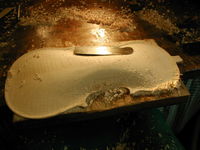Benjamin Banks Project
Benjamin banks, "The Salisbury Violin maker" 1727 - 1795
This English violin maker of the 18th century ranks among the finest of his period, contemporary with some of the Iconic Italian masters such as Antonio Stradivari, the Guarneri family and their successors, he has been overshadowed and largely overlooked by history because, unlike most other important English makers of the time, who operated chiefly from the capital, he conducted his business, and made his living in his home city of Salisbury.
In his early years, much of his output was anonymous, and sent to London for sale and distribution through a company known as Longman and Broderip, but later on his output was more easily identifiable as his, or his sons who later worked alongside of him in the family business.
His models and styles were driven by the trends in music at the time, and there was a huge demand for instruments styled on the Amati family from Cremona, particularly Nicolo Amati, and later Antonio Stradivari and also the German maker Jacobus Stainer.
Many of Benjamin Bank's instruments survive today, and are receiving their full appreciation from players around the world, and some have not strayed too far from where they were made, in particular a gorgeous small Viola, dated 1770, that is in the custody of the Salisbury cathedral Director of Music, and a Violin dated 1778, belonging to the City Council to be played by the leader of the city Symphony Orchestra.
As a maker, I am fascinated to learn more about the man and specifically his construction methods, and this project will involved a close measurement and almost forensic study of these two instruments, with specific focus being made on attempting to analyse his techniques derived from the English school, and how they differ from what has become the standard "Cremonese" method.
Some of these images clearly show the amazing workmanship of Benjamin, and they served me during the making process, othersl show the construction of their replicates as work progresses, and finally the finished instruments in baroque set-up.
To replicate these instruments as accurately as possible was the challenge for me, but I have tried to make them as they would have left Benjamins' bench in Catherine Street centuries before, and I will leave it to the forthcoming centuries to decide how they eventually look.
This English violin maker of the 18th century ranks among the finest of his period, contemporary with some of the Iconic Italian masters such as Antonio Stradivari, the Guarneri family and their successors, he has been overshadowed and largely overlooked by history because, unlike most other important English makers of the time, who operated chiefly from the capital, he conducted his business, and made his living in his home city of Salisbury.
In his early years, much of his output was anonymous, and sent to London for sale and distribution through a company known as Longman and Broderip, but later on his output was more easily identifiable as his, or his sons who later worked alongside of him in the family business.
His models and styles were driven by the trends in music at the time, and there was a huge demand for instruments styled on the Amati family from Cremona, particularly Nicolo Amati, and later Antonio Stradivari and also the German maker Jacobus Stainer.
Many of Benjamin Bank's instruments survive today, and are receiving their full appreciation from players around the world, and some have not strayed too far from where they were made, in particular a gorgeous small Viola, dated 1770, that is in the custody of the Salisbury cathedral Director of Music, and a Violin dated 1778, belonging to the City Council to be played by the leader of the city Symphony Orchestra.
As a maker, I am fascinated to learn more about the man and specifically his construction methods, and this project will involved a close measurement and almost forensic study of these two instruments, with specific focus being made on attempting to analyse his techniques derived from the English school, and how they differ from what has become the standard "Cremonese" method.
Some of these images clearly show the amazing workmanship of Benjamin, and they served me during the making process, othersl show the construction of their replicates as work progresses, and finally the finished instruments in baroque set-up.
To replicate these instruments as accurately as possible was the challenge for me, but I have tried to make them as they would have left Benjamins' bench in Catherine Street centuries before, and I will leave it to the forthcoming centuries to decide how they eventually look.

Benjamin Banks 1770 Viola

1770 Viola back

Banks 1770 Viola front

Banks 1770 "Cathedral" Viola

Banks 1787 Violin, Salisbury City

Banks 1787 Violin front

Banks 1787 Violin back

Banks 1787 violin, peghead and scroll

Base board method of assembly, Assembling ribs to the blocks

Rib assembly complete with linings and trimmed blocks

Neck and scroll shaping, here are both violin and viola blocks being worked

Marking out the back outline using the rib assembly, note use of alignment string to ensure correct geometry

Back arching taking final shape using scrapers and low lighting

Finished belly with holes and bass-bar fitted

Closing the box, back and belly attached

1770 Viola back

1770 Viola front

1770 Viola neck and scroll

1787 Neck and scroll

1787 Violin Back


